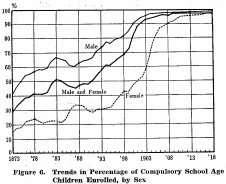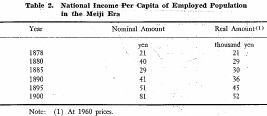| Home > Policy > White Paper, Notice, Announcement > White Paper > JAPAN'S GROWTH AND EDUCATION 1963 > CHAPTER |
||
The Meiji Government, which started the modernization of Japan later than the Western countries, endeavoured to secure her independence and to develop the country toward the level already achieved by the advanced countries of the world by introducing modern production methods and at the same time adopting modem military, administration and financial institutions under such slogans as "Enrich the country and strengthen its arms", "Increase products and promote industries" and "Civilize the country autd enlighten the people".
The establishment of a national educational system constituted one objective of such policies. In the 5th year of Meiji, 1872, following the educational system of the West, the Government Order of Education was promulgated based on the modern idea of equal opportunity of education. This heralded the dawn of modern education in Japan.
The modernization of Japan was accelerated by governmental action to abolish the feudal caste system and to establish a national modem education system in order to develop industries and increase production.
Even in the Tokugawa Era (17th-19th century), temple schools and other private schools enjoyed considerable popular support. Thus, the efforts of the Government to establish a modern educational system were favored by the people. As a result, the percentage of elementary school attendance rose from only 28 per cent in 1873 to over 50 per cent as early as 1883, and has exceeded 96 per cent since 1906.
However, at the time when the seed of modern industry was just shown, more than 80 per cent of the entire employed population were engaged in primary industries such as agriculture, fishing and mining, and the national income was only one tenth of the present. Elementary education was initiated under the national policy that, except for poor families, tuition should be borne by the parents, based on the idea that education was for the benefit of the people themselves. This caused the drop of the percentage of school attendance around 1886. In this year the four-year compulsory system was promulgated for the first time. The subsequent drop in the percentage of school attendance is believed to have resulted from rigorous collection of school tuition to meet increasing requirements of governmental costs.
The low national income per capita of the employed population at the time of the decline in the percentage of school attendance is shown in the table below.
The Government Order of Education of 1872 provided that an adequate amount of elementary school tuition was about 50 sen (0.5 yen) per month. Considering that the annual income per capita of the employed population in 1878 was 21 yen, the tuition was a considerab1e burden on ordinary households.
However, the efforts of the Japanese people to achieve the modernization of the country brought results earlier than had been expected. From the period of the Sino-Japanese War (1894-95) to the Russo-Japanese War (1904-05), light industry increased greatly in Japan, with spinning playing the most active part, and the foundation for the development of heavy industry was laid as a result of.mi1itary necessity. The income of the people increased gradually and the percentage of compulsory school attendance resumed its rapid rate of increase.
In 1900 the regulation concerning the levying of tuition in elementary school was abolished. In 1907 compulsory education was extended to six years. However, this did not reduce the percentage of compulsory school attendance, which had reached the level of 98 per cent, a figure representing almost perfect attendance, one of the reasons for such a high level of compulsory school attendance, achieved at such an early date, may be found in the early spread of upper elementary schools beyond the four-year compulsory elementary schools. Another and more effective reason may be found in the popular favor of compulsory education.
It is noteworthy that in the 30 years after the introduction of the modern school system, compulsory education was almost universally observed, and the general modernization of Japan was achieved in the same period. The rapidity of these developments was made possible by the fact that such social and cultural factors as religion, language and race did not constitute obstacles to the modernization in Japan. However, it must be emphasized that the people as well as their leaders entertained great expectations of modern education and made utmost efforts for its development.


| Back to Top | MEXT HOME |